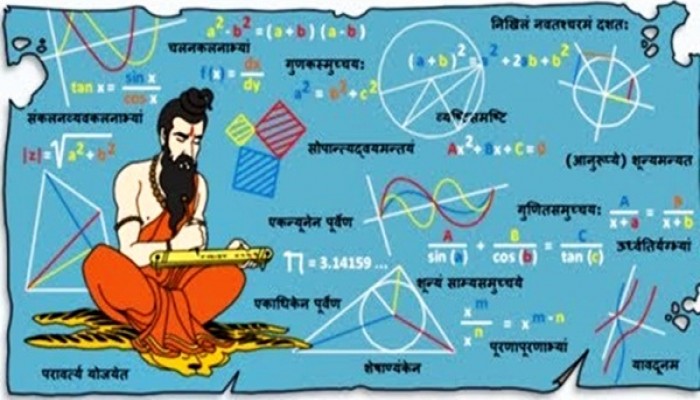Algebra Originated in India
- In Mathematics, Science & Technology
- 06:27 PM, Jul 05, 2021
- Chandrahas Halai
षड्भागः पाटलीषु भ्रमरनिकरतः स्वत्रिभागः कदम्बे
पादश्चूतद्रुमे च प्रदलितकुसुमे चंपके पंचमांशः ।
प्रोत्फुल्लांभोजखंडे रविकरदलिते त्रिंशदंशोऽभिरम्ये
तत्रैको मतभृंगो भ्रमति वद सखे का भवेद् भृंगसंख्या ॥५७॥
One-sixth of the bees in a colony of bees went to a Paatali flower (Stereospermum suaveolens, पाटली), one-third went to the kadamba tree (Burflower tree), one-fourth flew off to a mango tree and one-fifth went to the champaka tree and one-thirtieth went off to a beautiful bed of lotuses. If only one bee was buzzing around then tell me O friend! How many bees were there in the colony?
The above problem on Algebra is from Bhaskaracharya’s (Bhaskaracharya II) (Born 1114 AD) book Lilavati. Bhaskaracharya had composed this book in 1150 AD to teach Mathematics to his daughter Lilavati, after whom the book is named. This book which is written entirely in verse covers arithmetic, algebra, geometry, mensuration, combinatorics, number theory and other basic topics. This book was used as a standard textbook for almost 700 years.
The subject of Algebra originated in India. Its origin can be traced back to the Shatapatha Brahmana (शतपथब्राह्मण) (2000 BCE) and the Sulba sutras (800-500 BCE). Algebra was used to design and construct the vedis.
The Indian name for algebra is Bijaganita (बीजगणित). Bija (बीज) means analysis and ganita (गणित) means “the science of calculation”. Thus Bijaganita literally means “the science of analytical calculation”. Algebra is also called अव्यक्त गणित (avyakta ganita), that is the “the science of calculation with unknowns” (avyakta means unknown). Whereas Arithmetic is व्यक्त गणित (vyakta ganita), that is the “the science of calculation with knowns”.
According to Bhaskaracharya the science of calculation with unknowns is the source of the science of calculation with knowns.
The above problem is a Linear equation (equation where all the unknowns / variables are of the first degree) with one unknown. Initially, Indian mathematicians used the method of optional number to solve such problems which was later dropped.
In this article let us look at some interesting problems on linear equations with one unknown from Bhaskaracharya’s Lilavati.
Let us solve the above problem:
Let the number of bees in the colony be x.
Then, the number of bees that went to the Paatali flower will be x/6.
The number of bees that went to the Kadamba tree will be x/3.
The number of bees that went to the Mango tree will be x/4.
The number of bees that went to the Champaka tree will be x/5.
The number of bees that went to the Lotuses will be x/30.

Thus, there were 60 bees in the colony.
Let us now look at few more interesting problems from Lilavati.
अमलकमलराशेस्त्र्यंशपंचांशषष्ठैः
त्रिनयनहरिसूर्या येन तुर्येण चार्या ।
गुरुपदमथ षड्भिः पूजितं शेषपद्मैः ।
सकलकमलसंख्यां क्षिप्रमाख्याहि तस्य ॥५५॥
From a bunch of lotuses, one-third were offered to Lord Shiva (त्रिनयन), one-fifth to Lord Vishnu (हरि), one-sixth to Surya Deva, one-fourth to the goddess. The remaining six were offered to the Guru. Tell me quickly the number of lotuses in the bunch.
Solution:
Let the number of lotuses be x.
Then, the number of lotuses offered to Lord Shiva will be x/3.
The number of lotuses offered to Lord Vishnu will be x/5.
The number of lotuses offered to Surya deva will be x/6.
The number of lotuses offered to the Goddess will be x/4.

Thus, there were 120 lotuses in the bunch.
Let us now look at one more interesting problem of the same type.
यूथार्धं सत्रिभागं वन्विवरगतं कुंजराणं च दृष्टम्
षड्भागश्चैव नध्यां पिबति च् सलिलं सप्तमांशेन मिश्रः ।
पद्मिन्यां चाष्टमांशः स्वनवमसहितः क्रीडते सानुरागो
नागेन्द्रो हस्तिनीभिस्तिसृभिरनुगतः का भवेध्यूथसंख्या ॥५४॥
One-half and one-third of the half of a group of elephants went into a cave. One-sixth and one-seventh of one-sixth were drinking water from a river. One-eighth and one-ninth of one-eighth were playing in a pond full of lotuses. The king of elephants was walking with three female elephants. Tell me how many elephants were there in the group?
Solution:
Let the number of elephants in the group be x.
Then the number of elephants that went into the cave will be

The number of elephants that were drinking water from the river will be

The number of elephants that were playing in the pond of lotuses will be

Thus, we have

Solving this we get
x = 1008
Thus, there were 1008 elephants in the group.
Bhaskaracharya and other ancient Indian mathematicians included practical and fun-filled examples in their texts to keep the students interested in the subject.
Image courtesy: myIndiamyGlory
Disclaimer: The opinions expressed within this article are the personal opinions of the author. MyIndMakers is not responsible for the accuracy, completeness, suitability, or validity of any information on this article. All information is provided on an as-is basis. The information, facts or opinions appearing in the article do not reflect the views of MyindMakers and it does not assume any responsibility or liability for the same.







Comments